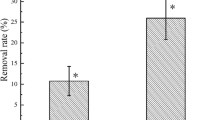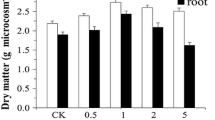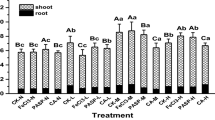Abstract
Purpose
Irrigation and fertilization accelerate the accumulation of environmental hormones such as 17α-Ethinyestradiol (EE2) and heavy metals such as Cd in soil, which in turn harms crops and human health. The objective of this study was to investigate the interaction of the plant ryegrass and EE2 degrading bacteria Hyphomicrobium sp. GHH on the remediation of EE2-Cd co-contaminated soil.
Materials and methods
The concentration of EE2 in soil was set as 25 mg kg−1, and the concentration of Cd was set as 0, 5, 20, and 80 mg kg−1, respectively. Pot experiments were carried out to investigate the control treatment without GHH inoculation and/or ryegrass cultivation (C), GHH inoculation alone (B), ryegrass cultivation alone (P), and combined use of ryegrass with GHH (B + P) on the EE2 and Cd removal from soil. The plant biomass, EE2 and Cd concentration in root and shoot of ryegrass, the bioconcentration factor (BCF), translocation factor (TF), phytoextraction efficiency of EE2 and Cd, and removal rate of EE2 and Cd from soil, as well as the soil urease activity and microbial biomass carbon (MBC) content, were determined to evaluate the interaction of plant and microbe on the soil remediation.
Results and discussion
After 28 days of treatment, in soil with spiked Cd at 5, 20, and 80 mg kg−1, the removal rate of EE2 from soil was: B + P > P > B > C; the effect on the Cd removal was B + P > P, while Cd cannot be removed by microbes directly. In B + P treatment, the removal rate was 89%, 80%, and 71%, respectively for EE2, and 0.81%, 0.43%, and 0.38% respectively for Cd. EE2 and Cd were mainly stored in root of ryegrass because that all the TFs were < 1. The inoculation of GHH significantly promoted plant growth and substantially increased the extraction efficiencies of EE2 and Cd by ryegrass (P < 0.05). Both cultivation of ryegrass and inoculation of GHH improved the soil environment, and the improving effect on the urease activity and MBC content was B + P > P > B > C. 5 mg kg−1 Cd increased soil urease activity and MBC content, and promoted the root growth. However, soil Cd at the concentration > 20 mg kg−1 caused irreparable harm to ryegrass and microorganisms; as the consequence, the EE2 extraction by plant significantly decreased (P < 0.05).
Conclusions
The combined use of ryegrass with GHH was effective to remediate the EE2-Cd co-contaminated soil.






Similar content being viewed by others
References
Aris AZ, Shamsuddin AS, Praveena SM (2014) Occurrence of 17α-ethynylestradiol (EE2) in the environment and effect on exposed biota: a review. Environ Int 69:104–119
Baran S, Bielińska JE, Oleszczuk P (2004) Enzymatic activity in an airfield soil polluted with polycyclic aromatic hydrocarbons. Geoderma 118(3–4):221–232
Bianco C, Defez R (2009) Medicago truncatula improves salt tolerance when nodulated by an indole-3-acetic acid-overproducing Sinorhizobium meliloti strain. J Exp Bot 60(11):3097–3107
Binet P, Portal JM, Leyval C (2000) Dissipation of 3-6-ring polycyclic aromatic hydrocarbons in the rhizosphere of ryegrass. Soil Biol Biochem 32:2011–2017
Calabrese EJ, Baldwin LA (2003) Toxicology rethinks its central belief. Nature 421(6924):691–692
Chen YX, Lin Q, Luo YM, He YF, Zhen SJ, Yu YL, Tian GM, Wong MH (2003) The role of citric acid on the phytoremediation of heavy metal contaminated soil. Chemosphere 50(6):807–811
Chen Z, Sheng X, He L, Huang Z, Zhang W (2013) Effects of root inoculation with bacteria on the growth, Cd uptake and bacterial communities associated with rape grown in Cd-contaminated soil. J Hazard Mater 244–245:709–717
Chiou CT, Sheng GY, Manes M (2001) A partition-limited model for the plant uptake of organic contaminants from soil and water. Soil Biol Biochem 35(7):1437–1444
Fidalgo F, Freitas R, Ferreira R, Pessoa AM, Teixeira J (2011) Solanum nigrum L. antioxidant defence system isozymes are regulated transcriptionally and posttranslationally in Cd-induced stress. Environ Exp Bot 72:312–319
Flores MIA, Romero-Gonza’lez R, Frenich AG, Vidal JLM (2011) QuEChERS-based extraction procedure for multifamily analysis of phytohormones in vegetables by UHPLC-MS/MS. J Sep Sci 34(13):1517–1524
Ganesan V (2008) Rhizoremediation of cadmium soil using a cadmium-resistant plant growth-promoting rhizopseudomonad. Curr Microbiol 56(4):403–407
Gerhardt KE, Huang XD, Glick BR, Greenberg BM (2009) Phytoremediation and rhizoremediation of organic soil contaminants: potential and challenges. Plant Sci 176(1):20–30
Glick BR (2010) Using soil bacteria to facilitate phytoremediation. Biotechnol Adv 28(3):367–374
Guo H, Yao J, Cai MM, Qian YG, Guo Y, Richnow HH, Blake RE, Doni S, Ceccanti B (2012) Effects of petroleum contamination on soil microbial numbers, metabolic activity and urease activity. Chemosphere 87:1273–1280
He L, Chen Z, Ren G, Zhang Y, Qian M, Sheng X (2009) Increased cadmium and lead uptake of a cadmium hyperaccumulator tomato by cadmium-resistant bacteria. Ecoto Environ Safe 72:1343–1348
He SY, Wu QL, He ZL (2014) Synergetic effects of DA-6/GA(3) with EDTA on plant growth, extraction and detoxification of Cd by Lolium perenne. Chemosphere 117:132–138
He SY, Guo HH, He ZL, Yang CP, Yu T, Chai QW, LU L (2019) Interaction of Lolium perenne and Hyphomicrobium sp. GHH enhances the removal of 17α-ethinyestradiol (EE2) from soil. J Soils Sediments 19:1297–1305
He SY, Guo HH, He ZL, Wang L (2019b) Effects of new-type cleaning agent MGDA with plant growth regulator DA-6 on phytoextraction of Cd-contaminated soils by ryegrass. Pedosphere 29:161–169
Hildebrand C, Londry KL, Farenhorst A (2006) Sorption and desorption of three endocrine disrupters in soils. J Environ Sci Heal B 41(6):907–921
Hogan NS, Duarte P, Wade MG, Lean DRS, Trudeau VL (2008) Estrogenic exposure affects metamorphosis and alters sex ratios in the northern leopard frog (Rana pipiens): identifying critically vulnerable periods of development. Gen Comp Endocrinol 156(3):515–523
Huang B, Sun WW, Li XM, Liu JL, Li Q, Wang RM, Pan XJ (2015) Effects and bioaccumulation of 17β-estradiol and 17α-ethynylestradiol following long-term exposure in crucian carp. Ecotox Environ Safe 112:169–176
Jeong S, Moon HS, Nam K, Kim JY, Kim TS (2012) Application of phosphate-solubilizing bacteria for enhancing bioavailability and phytoextraction of cadmium (Cd) from polluted soil. Chemosphere 88:204–210
Jha P, Panwar J, Jha PN (2018) Mechanistic insights on plant root colonization by bacterial endophytes: a symbiotic relationship for sustainable agriculture. Environ Sustain 1(1):25–38
Karnjanapiboonwong A, Chase DA, Canas JE, Jackson WA, Maul JD, Morse AN, Anderson TA (2011) Uptake of 17α-ethynylestradiol and triclosan in pinto bean, Phaseolus vulgaris. Ecotoxicol Environ Saf 74(5):1336–1342
Kuster M, López de Alda MJ, Barceló D (2005) Estrogens and progestogens in wastewater, sludge, sediments, and soil. Water Pollut 5:1–24
Li WC, Wong MH (2012) Interaction of Cd/Zn hyperaccumulating plant (Sedum alfredii) and rhizosphere bacteria on metal uptake and removal of phenanthrene. J Hazard Mater 209-210:421–433
Li FY, Qu XY, Wu RL (2005) Theoretical basis and technology of bioremediation of contaminated soil. Chemical Industry Press, Beijing (in Chinese)
Li WC, Ye ZH, Wong MH (2007) Effects of bacteria on enhanced metal uptake of the Cd/Zn-hyperaccumulating plant, Sedum alfredii. J Exp Bot 58(15-16):4173–4182
Liao CS, Yen JH, Wang YS (2006) Effects of endocrine disruptor di-n-butyl phthalate on the growth of Bok choy (Brassica rapa subsp. chinensis). Chemosphere 65(10):1715–1722
Lima DLD, Calisto V, Esteves VI (2011) Adsorption behavior of 17α-ethynylestradiol onto soils followed by fluorescence spectral deconvolution. Chemosphere 84(8):1072–1078
Liu H, Yuan M, Tan SY, Yang XP, Jing YX (2015) Enhancement of arbuscular mycorrhizal fungus (Glomus versiforme) on the growth and Cd uptake by Cd-hyperaccumulator Solanum nigrum. Appl Soil Ecol 89:44–49
Lu RK (1999) Soil argrochemistry analysis protocoes. China Agriculture Science Press, Beijing (in Chinese)
Ma Y, Rajkumar M, Freitas H (2009) Inoculation of plant growth promoting bacterium Achromobacter xylosoxidans strain Ax10 for the improvement of copper phytoextraction by Brassica juncea. J Environ Manag 90(2):831–837
Maria SD, Rivelli AR, Kuffner M, Sessitsch A, Wenzel WW, Gorfer M, Strauss J, Puschenreiter M (2011) Interactions between accumulation of trace elements and macronutrients in Salix caprea after inoculation with rhizosphere microorganisms. Chemosphere 84:1256–1261
MiPAF (Ministero delle Politiche Agricole e Forestali) (2000) Osservatorio nazionale pedologico e per la qualita del suolo, international society of soil science,Societa Italiana della Scienza del Suolo. Metodi di Analisi Chimica del Suolo.Franco Angeli Editore, Milano, Italy. fasciculated.D
Schnoor JL, Light LA, McCutcheon SC, Wolfe NL, Carreira LH (1995) Phytoremediation of organic and nutrient contaminants. Environ Sci Technol 29(7):318–323
Schroeder LM, Blackwell B, Klein D, Morse AN (2015) Rate uptake of three common pharmaceuticals in celery, Apium graveolens. Water Air Soil Poll 226(123):1–20
Sheng XF, Xia JJ (2006) Improvement of rape (Brassica napus) plant growth and cadmium uptake by cadmium-resistant bacteria. Chemosphere 64:1036–1042
Su YH, Zhu YG (2007) Transport mechanisms for the uptake of organic compounds by rice (Oryza sativa) roots. Environ Pollut 148(1):94–100
Tomšíková H, Aufartova J, Solich P, Novakova L, Ferrera ZS, Rodriguez JJS (2012) High-sensitivity analysis of female-steroid hormones in environmental samples. Ttac-Trend Anal Chem 34:35–58
Wang YY, Fang L, Lin L, Luan TG, Tam NFY (2014) Effects of low molecular-weight organic acids and dehydrogenase activity in rhizosphere sediments of mangrove plants on phytoremediation of polycyclic aromatic hydrocarbons. Chemosphere 99:152–159
Xu H, Yang J, Wang YX, Jiang Q, Chen H, Song HY (2008) Exposure to 17α-ethynylestradiol impairs reproductive functions of both male and female zebrafish (Danio rerio). Aquat Toxicol 88(1):1–8
Zhang X, Gao XJ, Li GX, Li QZ, Guo QH, Yan CZ (2011) Estrogenic compounds and estrogenicity in surface water, sediments, and organisms from Yundang Lagoon in Xiamen, China. Arch Environ Contam Toxicol 61(1):93–100
Zhu ZQ, Yang XE, Wang K, Huang HG, Zhang XC, Fang H, Li TQ, Alva AK, He ZL (2012) Bioremediation of Cd-DDT co-contaminated soil using the Cd-hyperaccumulator Sedum alfredii and DDT-degrading microbes. J Hazard Mater 235-236:144–151
Funding
This study was supported by the grant from National Natural Science Foundation of China (41501521, 41301327).
Author information
Authors and Affiliations
Corresponding author
Additional information
Responsible editor: Claudio Bini
Publisher’s note
Springer Nature remains neutral with regard to jurisdictional claims in published maps and institutional affiliations.
Rights and permissions
About this article
Cite this article
He, S., Li, Y., Guo, H. et al. Combined effect of ryegrass and Hyphomicrobium sp. GHH on the remediation of EE2-Cd co-contaminated soil. J Soils Sediments 20, 425–434 (2020). https://doi.org/10.1007/s11368-019-02358-8
Received:
Accepted:
Published:
Issue Date:
DOI: https://doi.org/10.1007/s11368-019-02358-8




